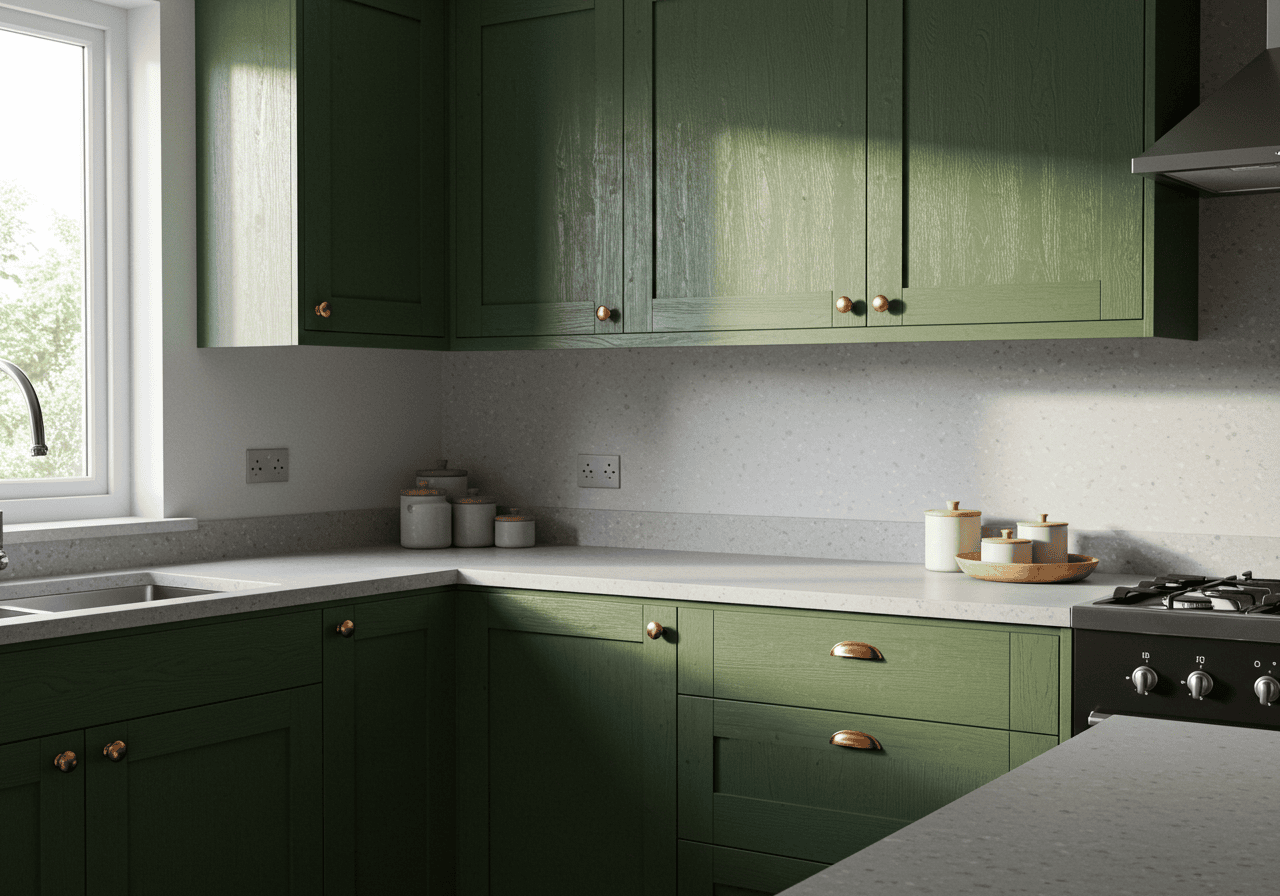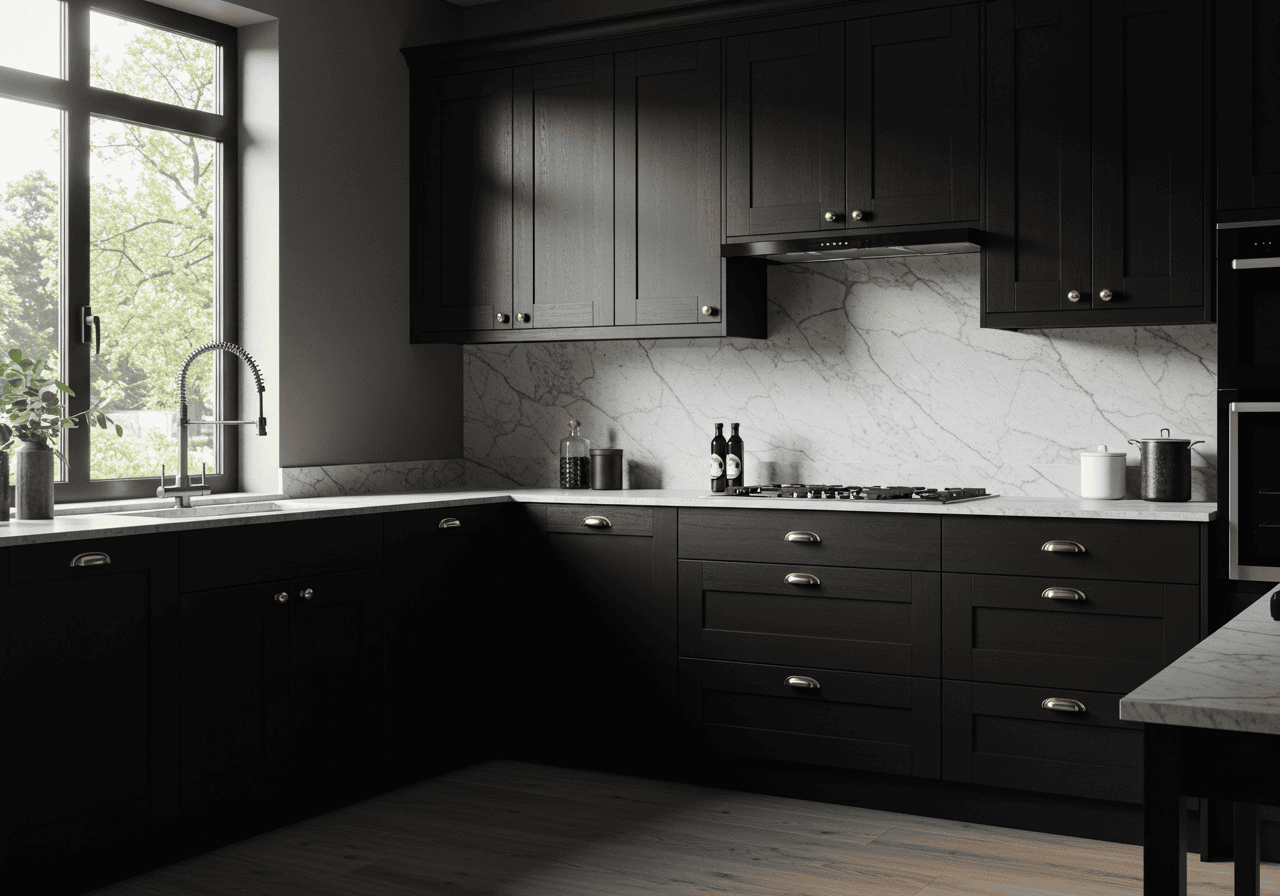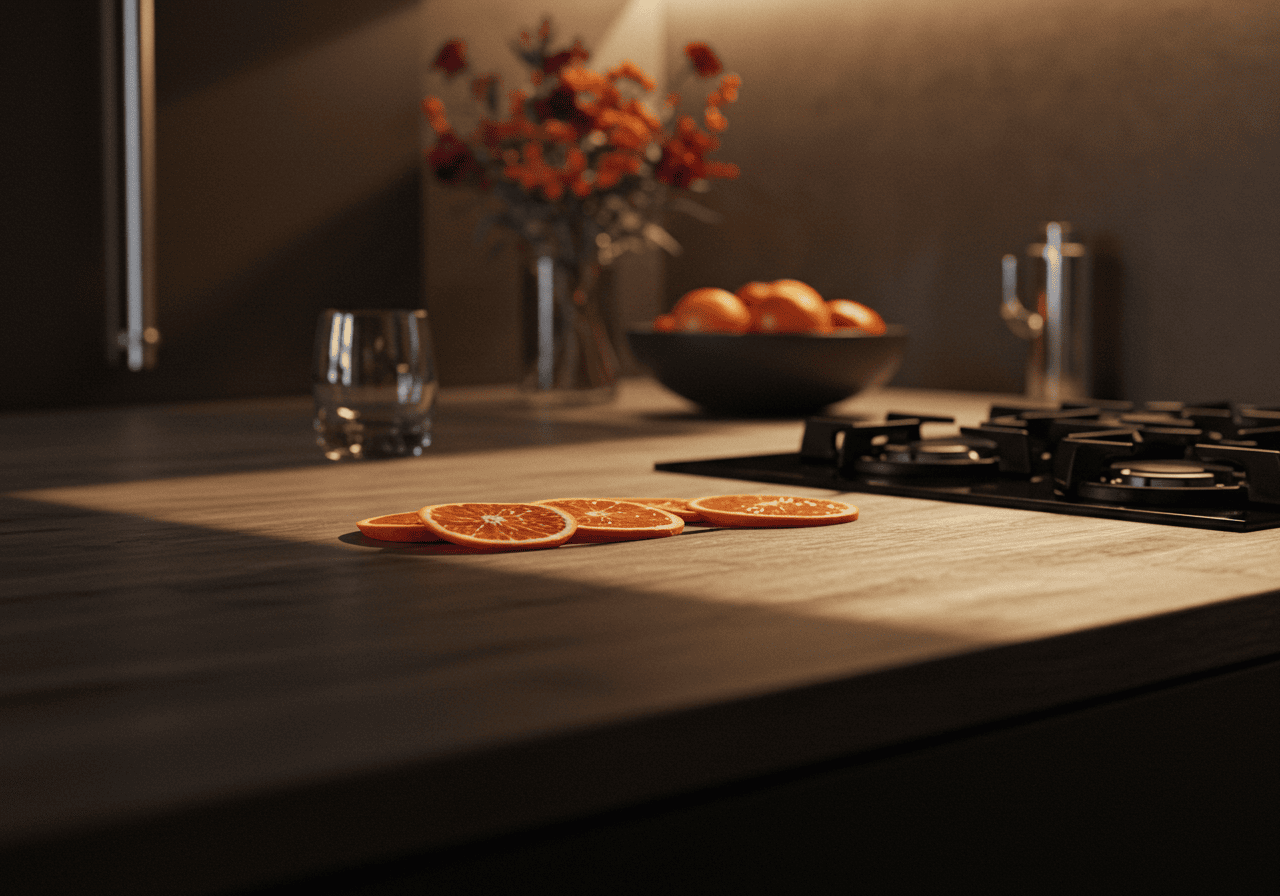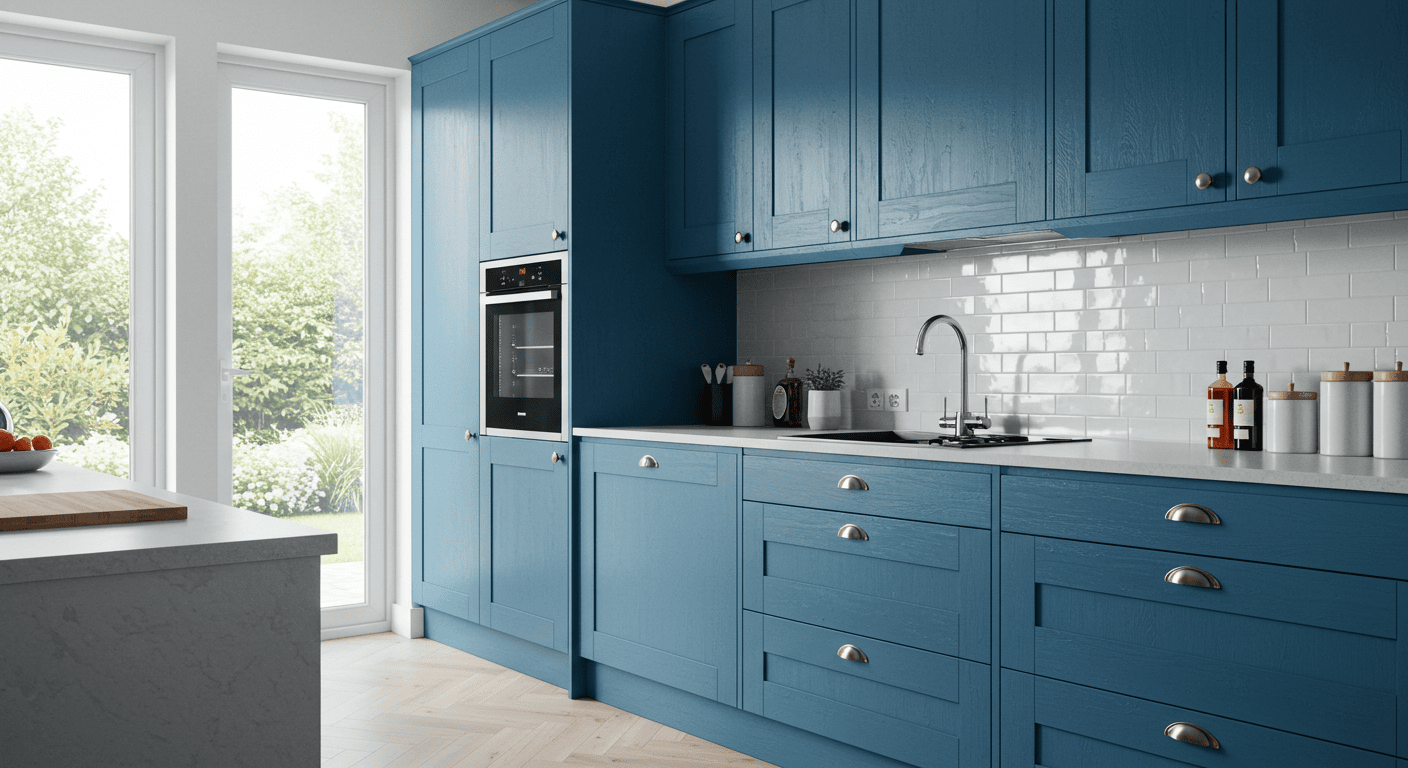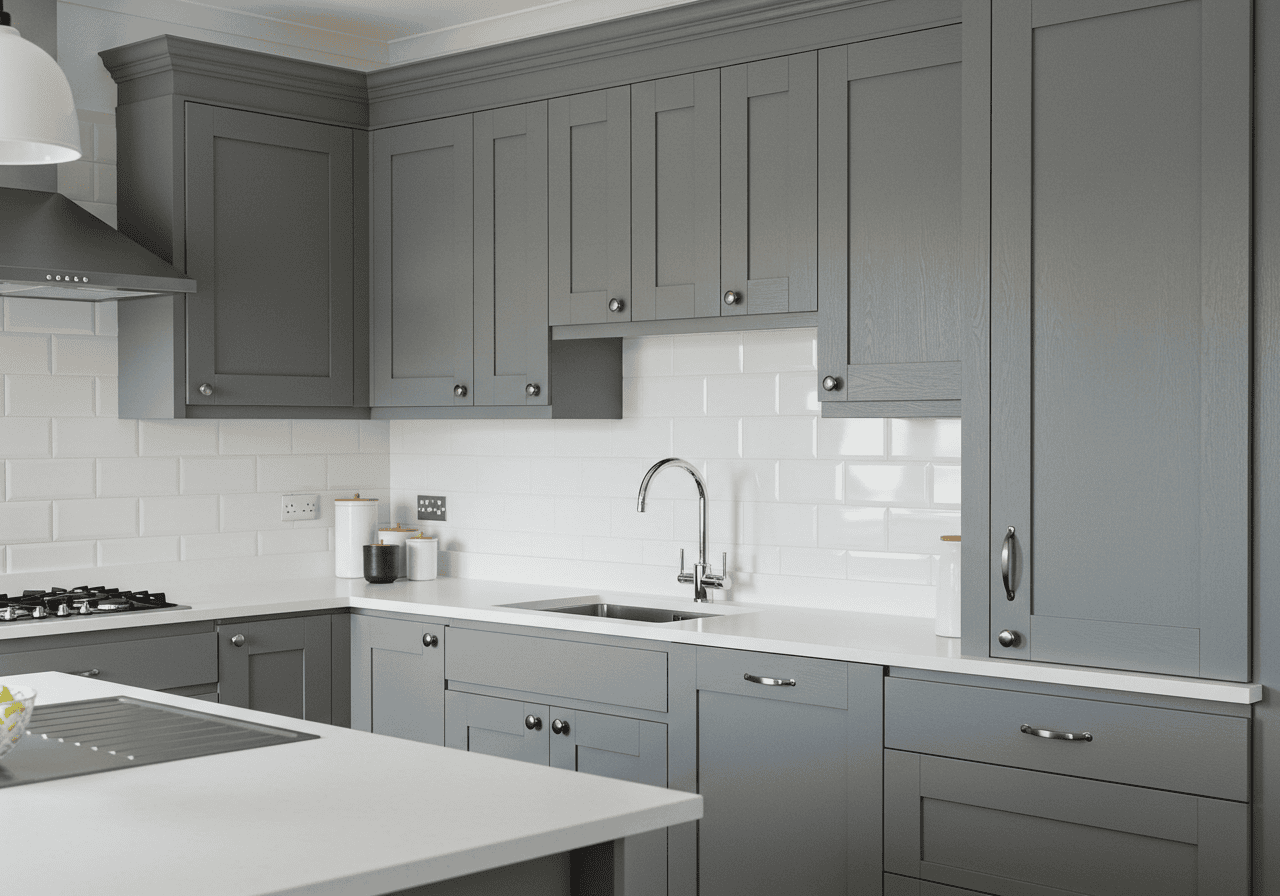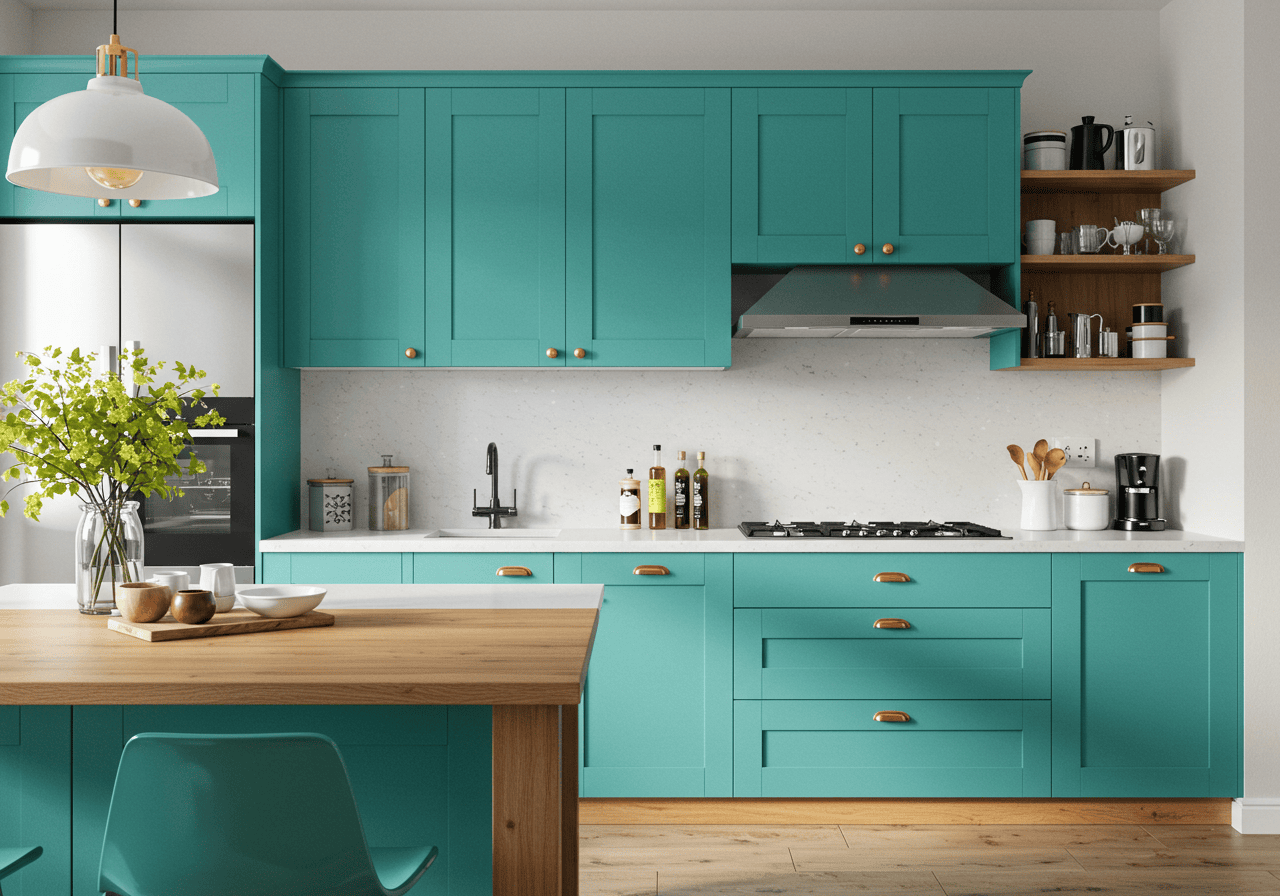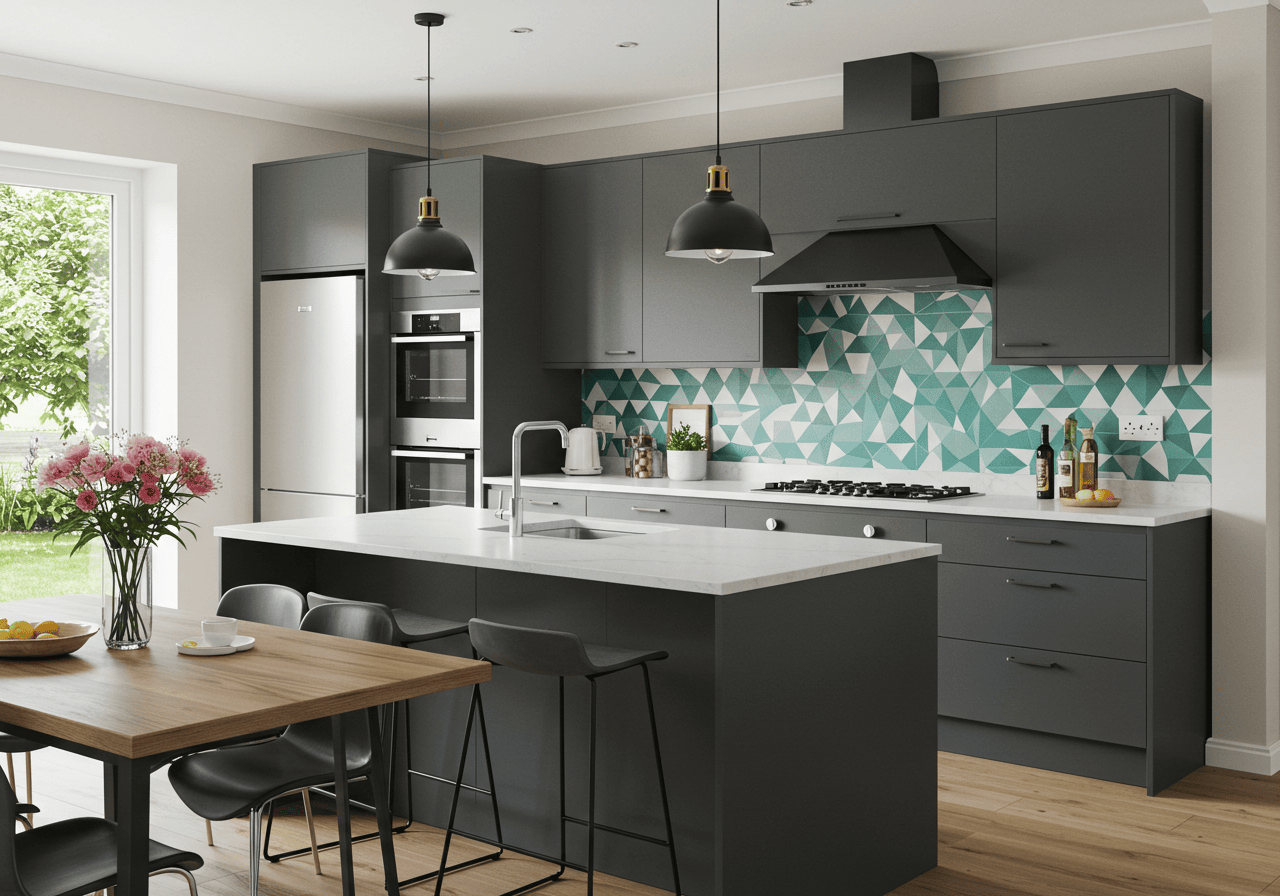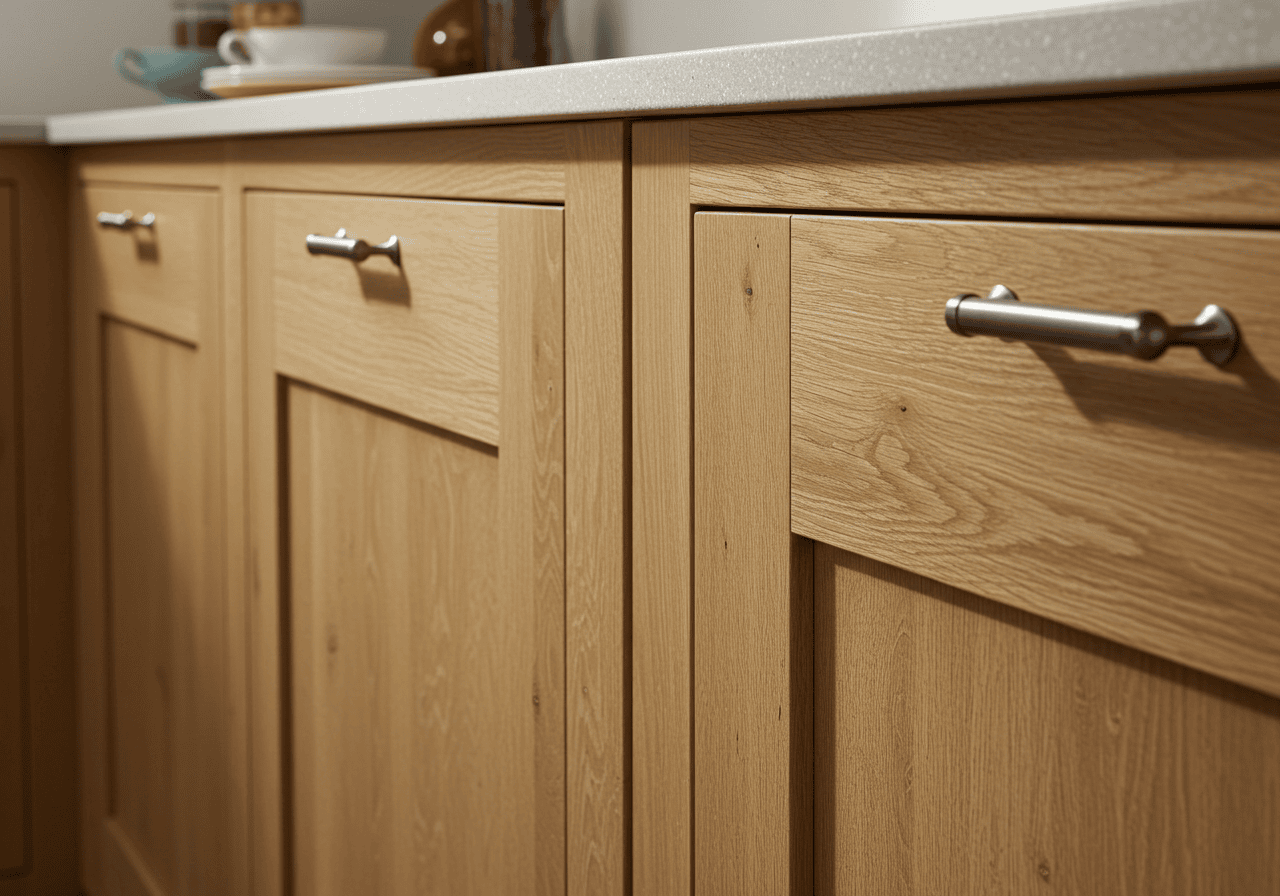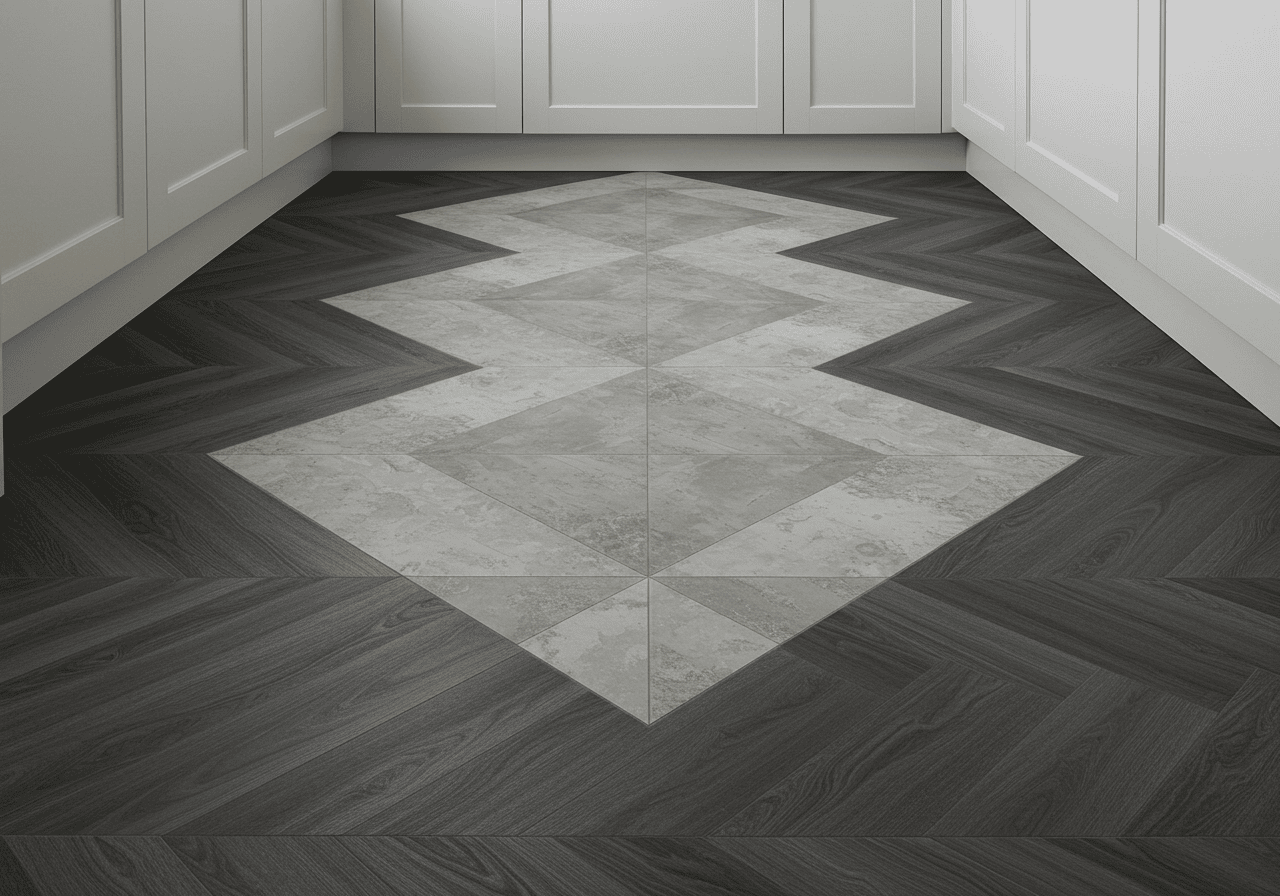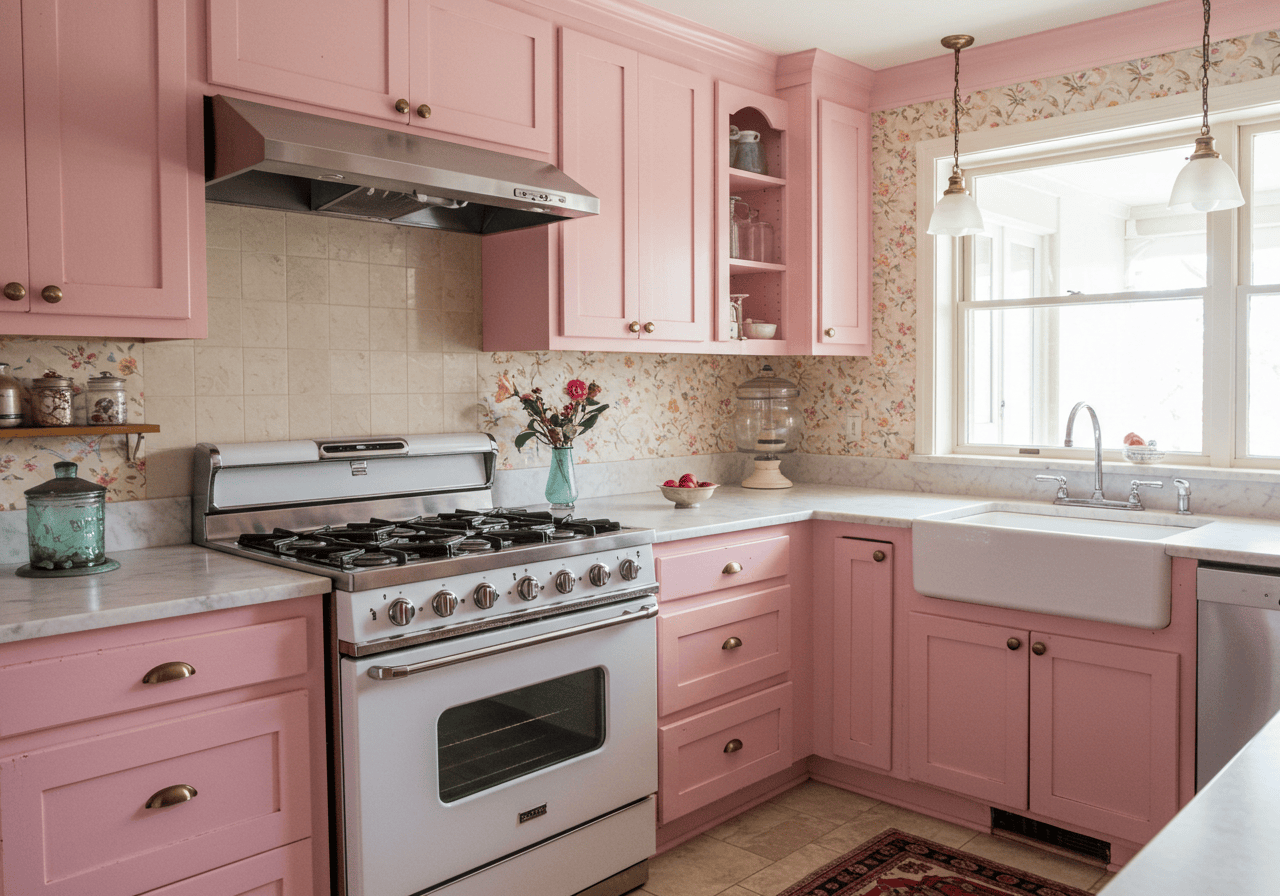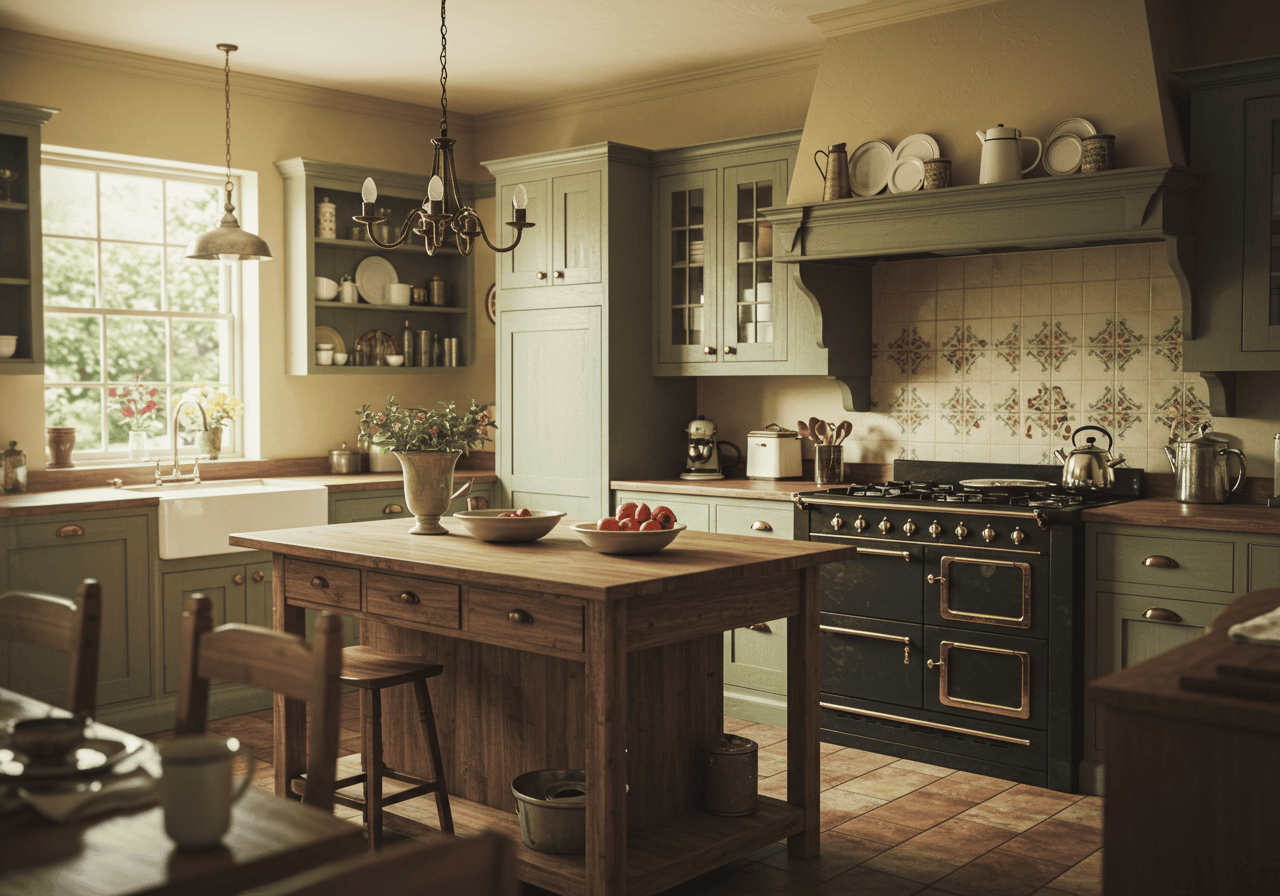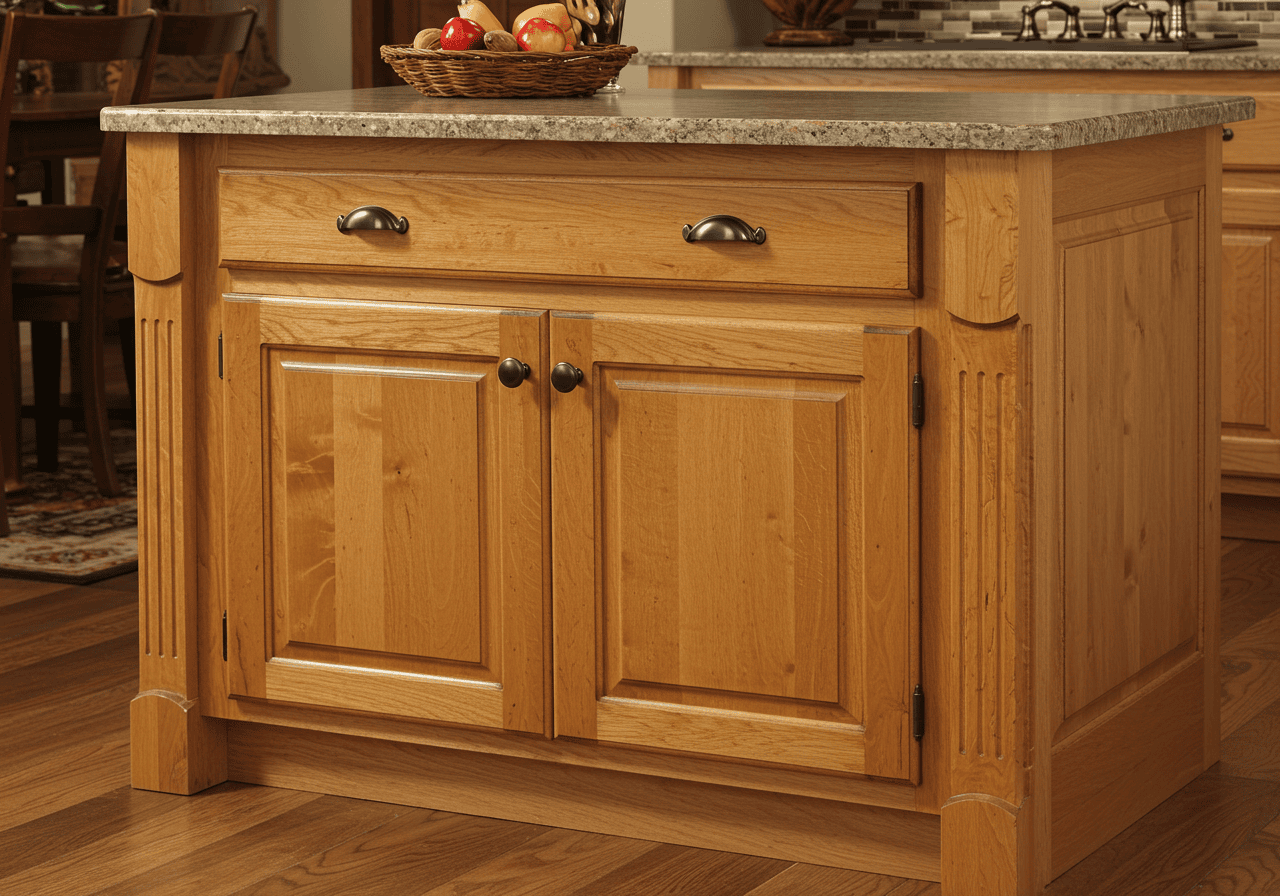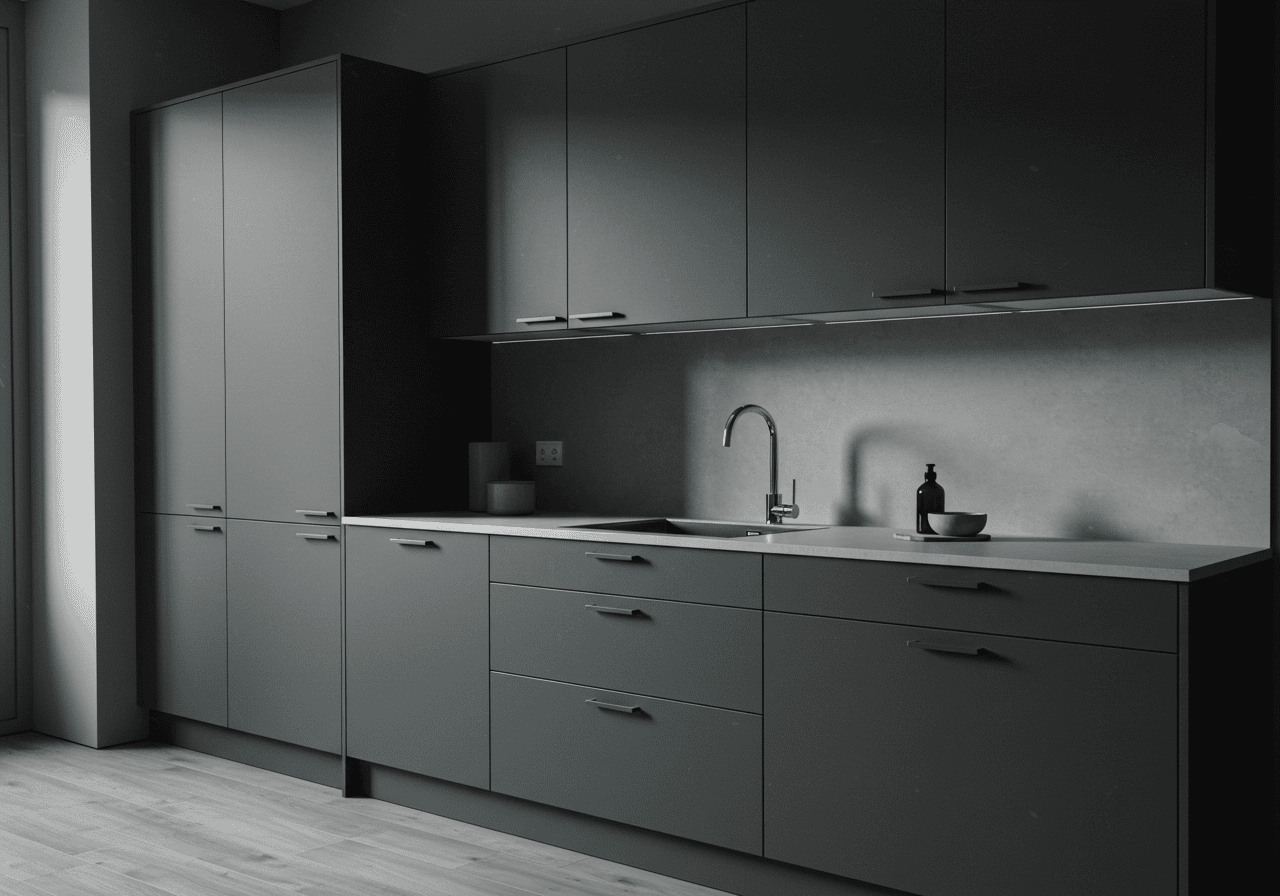Hey there, design lovers! Are you dreaming of a kitchen that feels both timelessly elegant and refreshingly bold? Tired of the same old white or gray? Then let’s talk about a color that’s taking the interior design world by storm: dark green.
From deep forest and rich emerald to muted olive and moody hunter green, this versatile hue brings a sense of calm sophistication, organic beauty, and undeniable personality to the heart of your home. Forget fleeting fads; dark green has a classic grounding power that works beautifully in spaces ranging from ultra-modern to charmingly rustic.
Ready to explore the possibilities? We’ve curated 21 stunning examples of dark green kitchen cabinets to show you just how gorgeous, adaptable, and utterly captivating this color can be. Get ready to be inspired! Considering other bold choices? Explore various kitchen cabinet color ideas to find your perfect match.
1. Emerald City Glamour: Jewel-Toned Brilliance
The Vibe: Think pure, unadulterated luxury. This look uses a rich, saturated emerald green with a subtle sheen (like a satin or semi-gloss finish) to create a truly jewel-like effect.
Why it Works: Emerald green feels opulent and inviting. It pairs exceptionally well with brass or gold hardware, which pops against the deep color like jewelry. Complement it with white marble countertops (bonus points for dramatic veining!) and perhaps a statement chandelier to complete the glamorous feel. This isn’t just a kitchen; it’s a statement.
Expert Tip: Keep surrounding elements relatively simple to let the emerald cabinets be the star. A simple white subway tile backsplash or even a continuation of the marble countertop material works wonders.
2. Modern Minimalist Matte: Sleek & Sophisticated
The Vibe: Clean lines, uncluttered surfaces, and a focus on form and function define this style. Here, dark green takes on a contemporary edge with a flat-panel (slab) cabinet style and an ultra-matte finish.
Why it Works: The matte finish absorbs light, giving the green a deep, velvety look that feels incredibly sophisticated and modern. This style often features minimalist hardware (think slim black bar pulls or even handleless push-to-open mechanisms). Pair it with concrete-look countertops or light wood accents for warmth and contrast. It’s perfect for achieving a high-end, streamlined aesthetic explored in modern kitchen ideas.
Expert Tip: Matte finishes can sometimes show fingerprints more easily, especially in dark colors. Opt for high-quality Fenix NTM or similar fingerprint-resistant materials if your budget allows, or simply keep a microfiber cloth handy!
3. Moody & Atmospheric: Embracing the Dark Side
The Vibe: Dramatic, enveloping, and undeniably cozy. This look leans into the darkness, pairing deep hunter or forest green cabinets with other dark elements like black countertops, dark backsplashes, or even dark wall paint.
Why it Works: Creating a cohesive dark palette can make a kitchen feel incredibly intimate and high-end. The key is to introduce texture and strategic lighting to prevent it from feeling gloomy. Think aged brass hardware, a textured tile backsplash (like Zellige), or dark wood open shelving. This approach shares a sophisticated depth often found in kitchens featuring black kitchen cabinets.
Expert Tip: Under-cabinet lighting and well-placed pendant lights are crucial here. They highlight work surfaces and add points of brightness, creating depth and preventing the space from feeling cavernous. Consider warmer bulb temperatures (around 2700K-3000K) to enhance the cozy factor.
4. Rustic Forest Retreat: Warm Wood & Green Harmony
The Vibe: Cozy, earthy, and inspired by nature. This style combines dark green cabinets (often a more muted, natural green like moss or olive) with plenty of natural wood tones.
Why it Works: Green and wood are a match made in heaven, evoking feelings of being in a tranquil forest. Use wood for countertops (like butcher block), open shelving, ceiling beams, or flooring. The warmth of the wood beautifully balances the coolness of the green. This style often incorporates elements seen in rustic kitchen designs.
Expert Tip: Choose a green with slightly grey or brown undertones to enhance the natural, earthy feel. Consider shaker-style cabinets or even beadboard details to lean into the rustic charm. Matte black or oil-rubbed bronze hardware complements this look perfectly.
5. Two-Tone Charm: Green Lowers, Light Uppers
The Vibe: Balanced, airy, and visually interesting. This popular approach uses dark green for the lower cabinets (grounding the space) while keeping the upper cabinets or shelves light (often white, cream, or even a very light wood).
Why it Works: It’s the best of both worlds! You get the rich color impact of dark green without overwhelming the space. Keeping the upper area light makes the kitchen feel taller and brighter, reflecting more light around the room. This strategy is a fantastic way to ease into a bolder color choice if you’re hesitant about going all-green. It’s a versatile approach highlighted in many kitchen decorating ideas.
Expert Tip: Ensure a cohesive element ties the two tones together. This could be consistent hardware across all cabinets, a backsplash tile that incorporates both light and green tones, or matching countertop materials throughout.
6. Vintage Vibes: Nostalgic Green Charm
The Vibe: Cozy, character-filled, and reminiscent of a bygone era. Think charming farmhouse or retro diner, but elevated with a sophisticated dark green palette.
Why it Works: Dark green, especially shades like muted olive or slightly desaturated forest green, pairs beautifully with vintage elements. Combine it with features like checkered floors, retro appliances (maybe a Smeg fridge?), apron-front sinks, and perhaps some beadboard detailing. This creates a warm, inviting space that feels both familiar and stylishly updated, perfect for a vintage kitchen aesthetic.
Expert Tip: Don’t be afraid to mix old and new. Pair your vintage-inspired green cabinets with modern pendant lighting or sleek countertops for a balanced look that avoids feeling like a time capsule. Hardware like cup pulls or latch closures enhances the vintage feel.
7. Mid-Century Modern Mood: Organic & Geometric
The Vibe: Stylishly retro yet timeless, blending organic shapes with clean lines. Dark green fits perfectly into the nature-inspired color palettes popular during the mid-century era.
Why it Works: Think flat-panel cabinets in a deep, earthy green (like Farrow & Ball’s ‘Green Smoke’ or ‘Studio Green’), often paired with warm wood tones, especially teak or walnut. The characteristic clean lines of mid-century modern kitchen design allow the rich green color and wood grain to shine. Look for geometric patterns in backsplashes or textiles and iconic lighting fixtures.
Expert Tip: Hardware is key here. Consider simple, elongated brass or wood pulls, or even integrated handles for that authentic MCM feel. Keep countertops simple – white quartz or a subtle terrazzo pattern works well.
8. High Contrast Pop: Green Meets Bright White
The Vibe: Crisp, clean, dynamic, and undeniably fresh. This look pairs bold dark green cabinets with brilliant white countertops, backsplashes, and potentially walls.
Why it Works: The stark contrast makes the green cabinets stand out dramatically, creating a focal point that feels both modern and energetic. The white elements bounce light around the room, ensuring the space feels bright and spacious despite the dark cabinet color. This high contrast really benefits from thoughtful kitchen lighting ideas to enhance the effect.
Expert Tip: Keep the palette tight – focus primarily on the green and white, with maybe one metallic accent (like chrome or black) for hardware and fixtures. Introducing too many other colors can dilute the powerful impact of the primary contrast.
9. Natural Stone Symphony: Green & Granite (or Quartzite!)
The Vibe: Grounded, luxurious, and organically beautiful. This approach pairs deep green cabinets with the natural patterns and textures of stone countertops like granite, quartzite, or even soapstone.
Why it Works: The natural movement and variation within the stone create a stunning visual counterpoint to the solid block of green color. Whether you choose a stone with warm gold veins, cool grey swirls, or subtle white flecks, it adds depth and a touch of earthy elegance. This pairing feels substantial and timeless.
Expert Tip: Bring a sample of your chosen green paint color when selecting your stone slab. View them together in natural light to ensure the undertones complement each other. Greens with a hint of grey or blue often pair beautifully with cooler-toned stones, while warmer greens work well with stones featuring gold or brown veins.
10. Modern Farmhouse Fresh: Green with Rustic Touches
The Vibe: A contemporary take on classic farmhouse style, blending clean lines with cozy, rustic elements and a sophisticated green palette.
Why it Works: Dark green brings a touch of modern sophistication to the familiar comforts of farmhouse style (think shiplap, apron sinks, open shelving). It feels less expected than white or grey but still maintains that connection to nature inherent in farmhouse design. Pair deep green shaker cabinets with butcher block countertops, a white subway tile backsplash (maybe with dark grout for contrast), and matte black hardware.
Expert Tip: Balance the dark green with plenty of white or light neutral elements to keep the space feeling bright and airy, a hallmark of modern farmhouse style. Consider incorporating textured elements like woven baskets or linen textiles. Good kitchen flooring ideas, like wide-plank wood or patterned tile, can also enhance this look.
11. Island Accent: A Pop of Powerful Green
The Vibe: Bold yet balanced. If committing to all-green cabinets feels too daunting, painting just the kitchen island a deep, dramatic green is a fantastic alternative.
Why it Works: The island becomes an immediate focal point, injecting personality and color without dominating the entire space. This allows you to keep the perimeter cabinets neutral (white, grey, or wood) for a lighter overall feel while still enjoying the richness of dark green. It’s a great way to experiment with color and create visual interest. This contrasts with the uniformity often seen with gray kitchen cabinets.
Expert Tip: Choose an island green that complements the other finishes in your kitchen. Consider the undertones of your main cabinets, countertops, and flooring. Using the same hardware on the island and perimeter cabinets helps tie the look together.
12. Small Kitchen Savvy: Making Dark Green Work in Compact Spaces
The Vibe: Clever, stylish, and space-smart. Proving that bold color isn’t just for large kitchens, this approach uses dark green strategically in smaller footprints.
Why it Works: While dark colors can sometimes make small spaces feel smaller, smart design choices prevent this. Using dark green primarily on lower cabinets keeps the eye level area lighter and more open. Pairing it with reflective surfaces like glossy white countertops, mirrored backsplashes, or high-shine finishes helps bounce light around. Excellent lighting is absolutely key. This shows dark green can be just as impactful, if not more so, in cozy kitchens.
Expert Tip: Consider using vertical lines to draw the eye upward – think vertically stacked tile backsplashes or tall, narrow cabinet doors if possible. Keeping upper cabinets light (or opting for open shelving) is crucial for maintaining an airy feel. Avoid overly bulky hardware.
13. Pattern Play: Green Cabinets & Statement Backsplash
The Vibe: Artistic, eclectic, and full of personality. This look pairs solid dark green cabinets with a boldly patterned backsplash tile.
Why it Works: The simple, consistent color of the dark green cabinets provides a perfect grounding canvas for a more intricate or colorful backsplash. Whether it’s geometric shapes, encaustic-look tiles, floral motifs, or even a unique mosaic, the backsplash becomes the star art piece of the kitchen, while the green cabinets add depth and sophistication.
Expert Tip: Choose a backsplash pattern that incorporates a touch of green or complementary colors (like terracotta, cream, or black) to create a cohesive look. Keep the countertop relatively simple to avoid visual clutter and let the backsplash truly shine.
14. Glass Front Glamour: Showcasing Collections
The Vibe: Elegant, refined, and slightly traditional, offering a glimpse into curated collections. Dark green cabinets featuring glass-front doors add a layer of sophistication.
Why it Works: Glass fronts break up the visual weight of solid dark cabinetry, making the kitchen feel lighter and more open. They provide an opportunity to display beautiful dishware, glassware, or decorative objects, adding personality and charm. The dark green frame around the glass creates a sophisticated contrast with the items displayed inside. This adds a display element often seen with traditional oak kitchen cabinets, but with a modern color twist.
Expert Tip: Keep the interiors of glass-front cabinets tidy! Consider painting the inside of the cabinet a contrasting light color (like white or pale wood) to make the items pop. Installing interior cabinet lighting further enhances the display effect.
15. Unexpected Pairing: Dark Green & Soft Pink Accents
The Vibe: Playful, chic, and surprisingly sophisticated. This daring combination pairs deep, grounding green with touches of soft, dusty pink.
Why it Works: It’s all about complementary contrast! The earthy depth of the dark green provides a mature base, while the soft pink adds a touch of warmth, whimsy, and modern femininity. This pairing feels fresh, unexpected, and incredibly stylish. Think pink tiles, small appliances, textiles, or even a painted accent wall. It’s a bolder, more grounded take on the charm found in a pink kitchen.
Expert Tip: Use pink sparingly as an accent color to avoid overwhelming the space or making it feel too juvenile. Focus on sophisticated shades of dusty rose or blush rather than bright bubblegum pink. Brass or gold hardware beautifully bridges these two colors.
16. Industrial Edge: Green Meets Raw Materials
The Vibe: Urban, edgy, and effortlessly cool. This style combines the organic feel of dark green with raw, industrial elements like exposed brick, concrete, metal, and reclaimed wood.
Why it Works: The contrast between the sophisticated dark green and the rough textures of industrial materials creates a compelling dynamic. Imagine deep green cabinets against a weathered brick wall, topped with concrete countertops, or accented with black metal shelving units and exposed ductwork. The green softens the harshness of the industrial elements while gaining an edgy character in return.
Expert Tip: Choose a green with slightly desaturated or grey undertones to better complement the neutral tones of concrete and metal. Matte finishes often work best in this style. Incorporate warm elements like reclaimed wood or vintage-style Edison bulbs to prevent the space from feeling too cold.
17. Sophisticated Pairing: Green Meets Grey
The Vibe: Understated elegance, modern, and calming. Pairing dark green cabinets with various shades of grey kitchen cabinets creates a sophisticated and serene atmosphere.
Why it Works: Grey acts as a perfect neutral companion to dark green, allowing the green to stand out without creating harsh contrasts. Light grey walls or countertops can brighten the space, while charcoal grey accents (like flooring or grout) can add depth and moodiness. This combination feels very contemporary and refined, offering a softer alternative to high-contrast pairings. While grey is often used on its own for cabinets, pairing it with green offers a unique twist.
Expert Tip: Pay attention to the undertones. A cool grey pairs well with blue-toned greens (like teal or deep aqua-greens), while warmer greys (greige) complement olive or mossy greens beautifully. Stainless steel appliances blend seamlessly into this color scheme.
18. Breathing Room: Green Cabinets & Open Shelving
The Vibe: Airy, curated, and personalized. Incorporating open shelving alongside dark green cabinets breaks up the density and provides stylish storage display opportunities.
Why it Works: Solid blocks of dark cabinetry can sometimes feel heavy, especially in smaller kitchens. Replacing some upper cabinets with open shelves (in natural wood, metal, or even painted white) introduces airiness and light. It’s a chance to display your favorite cookbooks, ceramics, plants, or glassware, adding personality and visual interest against the rich green backdrop.
Expert Tip: Curate your shelves thoughtfully! Cluttered open shelves can quickly make a kitchen feel messy. Stick to a cohesive color palette for displayed items and vary the height and texture of objects. Wood shelves add warmth, while black metal shelves offer a more industrial or modern edge.
19. Timeless Traditional Grandeur: Ornate Details & Deep Green
The Vibe: Classic, luxurious, and stately. This approach uses dark green within a traditional kitchen design framework, often featuring more ornate details.
Why it Works: Deep, rich greens like hunter or emerald feel inherently classic and pair beautifully with traditional cabinet styles (raised panels, detailed crown molding, decorative legs on islands). Combine them with luxurious materials like marble or granite countertops with ogee edges, ornate hardware (like polished nickel or antique brass knobs and pulls), and perhaps a decorative range hood. It creates a sense of established elegance and enduring style.
Expert Tip: Balance the richness of the green and ornate details with lighter elements, perhaps a creamy white backsplash or light natural stone flooring, to keep the space from feeling overly heavy. Glass-front cabinets with mullions can also add traditional charm while lightening the look. Ensure lighting highlights the details, perhaps with elegant sconces or a traditional chandelier.
20. Earthy Elegance: The Allure of Olive Green Cabinets
The Vibe: Warm, sophisticated, and subtly complex. Olive green, a muted shade with yellow and brown undertones, offers a softer, earthier take on the dark green trend.
Why it Works: Unlike its brighter emerald or deeper forest cousins, olive green feels inherently calming and grounded. It bridges the gap between neutral and color, making it incredibly versatile. It pairs beautifully with natural materials like wood (especially lighter oaks or walnuts), terracotta, aged brass, and creamy whites. Olive green creates a sophisticated yet inviting atmosphere, perfect for spaces aiming for understated elegance with an organic touch.
Expert Tip: Because of its muted nature, olive green works well in various lighting conditions. Consider pairing it with textures – a slightly rougher matte finish, beadboard details, or pairing with textured stone or tile to enhance its earthy quality. It’s a fantastic choice for achieving a look that feels both current and timelessly natural.
21. Biophilic Bliss: Bringing the Outside In
The Vibe: Serene, natural, and life-enhancing. This approach fully embraces the nature connection of green by pairing dark green cabinets with abundant natural light and living plants.
Why it Works: Dark green inherently evokes feelings of nature, forests, and tranquility. Amplifying this connection by ensuring ample natural light (large windows, skylights) and incorporating plenty of houseplants (hanging Pothos, countertop herbs, a statement Fiddle Leaf Fig in a corner) creates a kitchen that feels like a refreshing, calming oasis. The living greenery complements the cabinet color beautifully, enhancing the organic vibe.
Expert Tip: Position plants where they will receive appropriate light. Use simple, natural material planters (terracotta, ceramic, woven baskets) that harmonize with the green cabinets and other kitchen elements like wood or stone. Keep countertops relatively clear to allow sunlight to flood the space and highlight the richness of the dark green kitchen cabinets.
And there you have it – 21 ways dark green kitchen cabinets can transform your space from ordinary to extraordinary! We hope these ideas have sparked your imagination and shown you the incredible versatility and beauty of this captivating color. Happy decorating!

